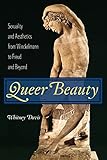Queer Beauty : Sexuality and Aesthetics from Winckelmann to Freud and Beyond / Whitney Davis.
Material type: TextSeries: Columbia Themes in Philosophy, Social Criticism, and the ArtsPublisher: New York, NY : Columbia University Press, [2010]Copyright date: ©2010Description: 1 online resource (368 p.)Content type:
TextSeries: Columbia Themes in Philosophy, Social Criticism, and the ArtsPublisher: New York, NY : Columbia University Press, [2010]Copyright date: ©2010Description: 1 online resource (368 p.)Content type: - 9780231146906
- 9780231519557
- 111.85 D2611q 22
- BH39 .D383 2010
- BH39 .D383 2010
- online - DeGruyter
- Issued also in print.
| Item type | Current library | Call number | URL | Status | Notes | Barcode | |
|---|---|---|---|---|---|---|---|
 eBook
eBook
|
Biblioteca "Angelicum" Pont. Univ. S.Tommaso d'Aquino Nuvola online | online - DeGruyter (Browse shelf(Opens below)) | Online access | Not for loan (Accesso limitato) | Accesso per gli utenti autorizzati / Access for authorized users | (dgr)9780231519557 |
Frontmatter -- Contents -- Preface -- Introduction: Sexuality and Aesthetics from Winckelmann to Freud and Beyond -- Queer Beauty -- The Universal Phallus -- Representative Representation -- Double Mind -- The Line of Death -- The Sense of Beauty -- The Aesthetogenesis of Sex -- Love All the Same -- The Unbecoming -- Fantasmatic Iconicity -- Notes -- Index
restricted access online access with authorization star
http://purl.org/coar/access_right/c_16ec
The pioneering work of Johann Winckelmann (1717-1768) identified a homoerotic appreciation of male beauty in classical Greek sculpture, a fascination that had endured in Western art since the Greeks. Yet after Winckelmann, the value (even the possibility) of art's queer beauty was often denied. Several theorists, notably the philosopher Immanuel Kant, broke sexual attraction and aesthetic appreciation into separate or dueling domains. In turn, sexual desire and aesthetic pleasure had to be profoundly rethought by later writers. Whitney Davis follows how such innovative thinkers as John Addington Symonds, Michel Foucault, and Richard Wollheim rejoined these two domains, reclaiming earlier insights about the mutual implication of sexuality and aesthetics. Addressing texts by Arthur Schopenhauer, Charles Darwin, Oscar Wilde, Vernon Lee, and Sigmund Freud, among many others, Davis criticizes modern approaches, such as Kantian idealism, Darwinism, psychoanalysis, and analytic aesthetics, for either reducing aesthetics to a question of sexuality or for removing sexuality from the aesthetic field altogether. Despite these schematic reductions, sexuality always returns to aesthetics, and aesthetic considerations always recur in sexuality. Davis particularly emphasizes the way in which philosophies of art since the late eighteenth century have responded to nonstandard sexuality, especially homoeroticism, and how theories of nonstandard sexuality have drawn on aesthetics in significant ways. Many imaginative and penetrating critics have wrestled productively, though often inconclusively and "against themselves," with the aesthetic making of sexual life and new forms of art made from reconstituted sexualities. Through a critique that confronts history, philosophy, science, psychology, and dominant theories of art and sexuality, Davis challenges privileged types of sexual and aesthetic creation imagined in modern culture-and assumed today.
Issued also in print.
Mode of access: Internet via World Wide Web.
In English.
Description based on online resource; title from PDF title page (publisher's Web site, viewed 02. Mrz 2022)


